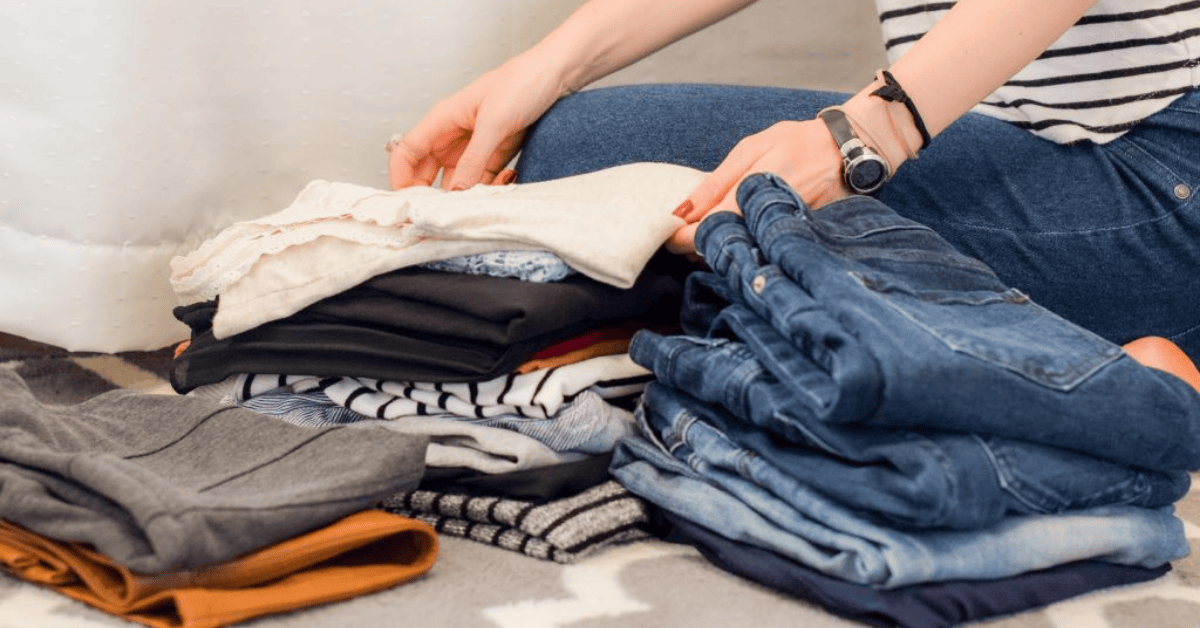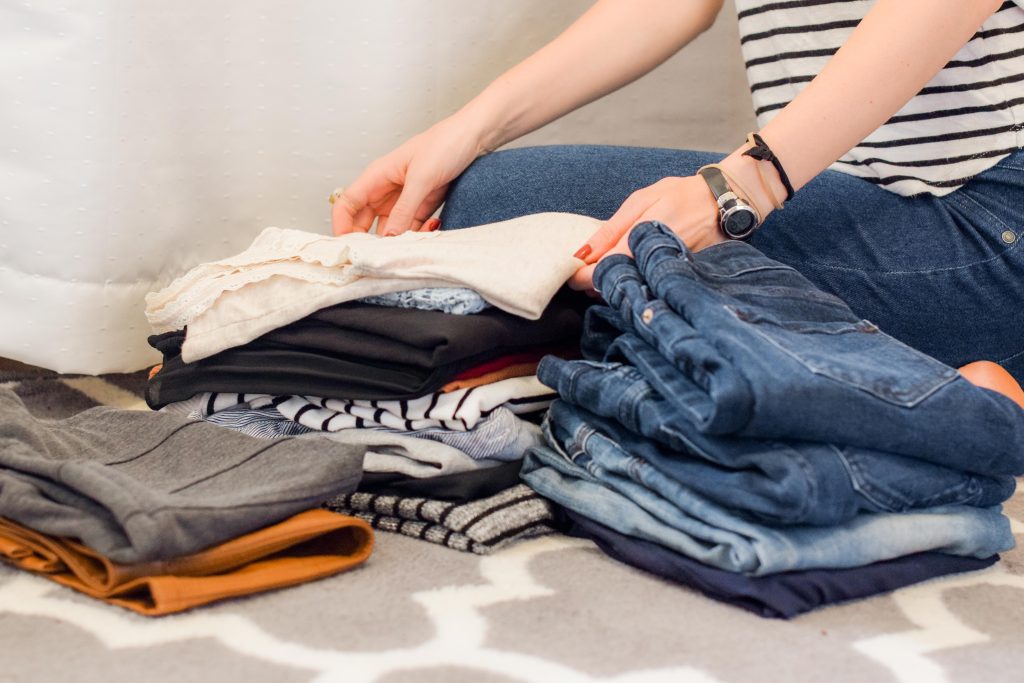How to Pack Clothes for Moving: 15 Packing Tips for a Smooth Transition

One of the most stressful tasks of moving is packing and organizing your belongings. Among the many items to pack, clothes pose a significant challenge. It tends to be bulky, prone to wrinkles, and requires careful handling to avoid damage.
These 15 packing tips can teach you how to pack clothes for moving, ensuring that your wardrobe arrives at your new home in pristine condition. Whether you’re packing for a local move across town or embarking on a long-distance relocation, these tips will help you pack your clothes with ease and minimize the risk of damage or wrinkles.

1. Declutter and Downsize Your Wardrobe
To make your moving experience as simple as possible, you may want to declutter and downsize your wardrobe before packing. The downsizing process means you only move clothes you love and want to keep to your new home. Decluttering will not only make packing easier but also reduce the amount of space you’ll need in your new home.
Take some time to assess your clothing items. You may want to discard clothes in poor condition. You can donate gently-used clothes that you no longer wear or fit poorly.
2. Sort Clothes
Ensure your clothes don’t get lost in the shuffle by establishing an organization system. It can help make packing and unpacking more efficient. There are a few methods you can use to organize your clothes. Some of these include:
- Packing by Season: Marking your seasonal weather can help prioritize what clothes to unpack first. There’s no need to unpack your off-season clothes if you are still enjoying summer. This will free up space in your closet and make packing more manageable.
- Packing by Type: Try sorting your clothes by type. Organizing your sweaters, pants, and shirts will make it easier to identify which packing supplies will keep specific items safe during the move. For example, suits may go in a garment bag while t-shirts can go into a wardrobe box.
- Packing by Family Member: Keeping everyone’s items separate makes it easier to unpack at your new home. It can make it more manageable to unpack clothing when every family member has their boxes labeled and organized.
You can take your organization a step further by creating a clothing inventory. It will help keep track of your clothing, which box or bag it was packed in, and ensure everything arrives at your new home.
3. Decide on Packing Method: Boxes or Bags
When packing clothes, you have the choice of using cardboard boxes or garment bags. The material you use can provide different benefits, depending on the type of clothing. Here is a general overview of what clothes fit which packing materials:
- For hanging clothes, a wardrobe box is the preferred option, as it keeps clothes organized and wrinkle-free.
- For non-hanging clothes, cardboard boxes or plastic storage containers are suitable.
- A garment bag is useful for delicate or formal clothing items that require extra protection.
If you’re packing a large quantity of clothes, consider hiring professional packers to save time and ensure proper handling. It can help remove a lot of stress surrounding the packing process since they can help make these decisions for you.
4. Gather Packing Supplies
Once you’ve decided on the packing method, you’ll need to gather the necessary packing supplies. The main packing materials you may need include:
- Wardrobe boxes: These sturdy boxes are specifically designed for packing hanging clothes, keeping them organized and wrinkle-free.
- Cardboard boxes: Regular moving boxes are ideal for packing non-hanging clothes, shoes, and other miscellaneous items.
- Garment bags: For formal clothing or delicate items, garment bags provide an extra layer of protection and prevent dust accumulation.
- Acid-free tissue paper: Use acid-free tissue paper to wrap delicate clothing items and prevent wrinkles. Acid-free tissue paper prevents discoloration and fabric damage.
- Bubble wrap: Provide additional cushioning for fragile or valuable items like shoes, purses, or jewelry.
- Packing tape: Securely seal all boxes and garment bags to prevent items from shifting or falling out during transport.
Before you purchase these packing supplies, you may want to consider checking with your moving company first. At Armstrong, we offer lay-flat boxes and other packing supplies to help make your moving process easier.
5. Pack Hanging Clothes with Care
Hanging clothing deserves special attention to prevent wrinkles and damage. Using wardrobe boxes will keep clothes on hangers during the move. Consider a wardrobe box as a small, portable closet.
If you don’t have enough wardrobe boxes, you can improvise using garbage bags or sheets to cover hanging clothes in a cardboard box.
6. Fold Non-Hanging Clothes Effectively
Folding non-hanging clothes properly can save space and minimize wrinkles. There are several folding techniques:
- Flat fold method
- Military rolling method
- KonMari method
The military rolling method may be the most popular and easiest option for folded clothes. The method involves rolling clothes to maximize space and prevent wrinkles.
As you pack your clothes in a cardboard box, use packing peanuts or bubble wrap to fill empty spaces in boxes. It will help prevent items from moving around during transit.
7. Utilize Vacuum Bags for Maximum Space Savings
For bulky items like sweaters, jackets, and out-of-season clothes, vacuum-sealed bags can significantly reduce volume. Vacuum bags let you store more clothes with less space – an ideal situation for moving since it can save space in moving trucks or storage units. Vacuum bags are also great for protecting clothes against moisture and dirt.
8. Pack Shoes Strategically
Shoes can take up a lot of space, so packing them efficiently is essential. Packing shoes also require extra attention to prevent damage during the move. Use shoe boxes or shoe inserts to keep shoes organized and prevent them from scuffing or damaging other items.
If you don’t have shoe boxes, you can stuff shoes with packing paper to maintain their shape. You can also use plastic bags to protect your shoes from damage.
9. Protect Delicate and Valuable Clothing
Delicate or valuable clothing items require extra care during packing. Use garment bags, bubble wrap, or acid-free tissue paper to protect these items from wrinkles, dust, discoloration, and other types of damage.
For extra protection, you may want to consider the double-combination of wardrobe boxes and garment bags to keep clothes protected and wrinkle-free. Another option is to use vacuum-sealed bags to prevent moths and other infestations from damaging your delicate clothing.
10. Label Boxes and Bags Clearly
Labeling boxes and bags is crucial for easy identification and organization at your new home. Depending on the organization method you choose, you can use labels to specify the contents of the cardboard box or garment bag. You may also want to consider using color-coding or stickers to further organize boxes and bags.
11. Utilize Dresser Drawers for Immediate Access
If you’re moving locally, consider leaving clothes in dresser drawers for easy unpacking and to save space in the moving truck. Here are a few other things to consider if you opt for this method:
- Securely wrap the dresser drawers shut with plastic wrap
- Take out heavier items to make the dresser easier to move
- You may need multiple people or a dolly to move the dresser in and out of the moving truck
- Use tie-downs inside the moving truck to prevent the dresser from shifting during transit
- Alternatively, you can take out the drawers and move them separately
12: Pack Essential Clothes and Items Separately
Set aside separate luggage or duffel bags with essential clothing items for the first few days at your new home. This should include a change of clothes, toiletries, and any medications you may need.
This will ensure that you have immediate access to essential items without having to unpack all of your belongings.
By packing a bag of essentials, you can avoid having to dig through boxes for basic necessities during the first few days in your new home. This will also give you time to unpack and organize your belongings at your own pace.
13. Transport Clothes Safely
When transporting clothes, ensure they are securely packed in taped boxes or plastic bins. You’ll also want to double-check that they are properly labeled. If you’re hiring movers, clearly communicate your packing methods and any special instructions for handling delicate or valuable items.
14. Unpack and Organize Clothes Promptly
Once you arrive at your new home, unpack your clothes promptly to prevent wrinkles and maintain organization. Your hanging clothes should go up in the closet immediately. You can then unpack your non-hanging clothes and store them in your closet, dresser, or other storage location.
15. Hire a Professional Household Moving Company
Professional movers have the expertise and experience to make the moving process as smooth as possible. At Armstrong, we offer end-to-end moving support. We can take care of the organization, packing, item disassembly and reassembly, transportation, and unpacking.
Hiring Armstrong will save you time and energy that you can redirect to settling into your new home. Overall, the decision to hire a moving company can make moving less stressful for you and your family.
Ready to get moving? Schedule a quote with Armstrong today.
